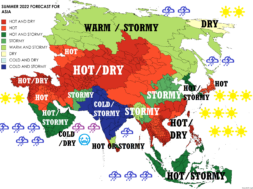
Climate change: As Europe battles worst drought in 500 years, China also issues alert
Virendra Pandit
New Delhi: As much of Europe and the Northern Hemisphere of the planet is battling either drought, wildfires, low water levels, harvest warnings, water use restrictions, or a mixture of all these, China, the world’s second-largest economy, has issued its first national drought alert of the year with officials trying to douse forest fires and mobilize specialist teams to protect crops from scorching temperatures across the Yangtze River basin.
Across Europe, the United Kingdom, Germany, France, Poland, the Netherlands, and many other countries are facing severe drought and water shortages. According to a New Scientist report, Europe is experiencing what may be its worst drought in 500 years, with river flows down by around a third on average.
The European drought, which may have been intensified by global warming, is seriously affecting food production and river transport when it is already facing a food crisis and soaring energy costs because of the Russian invasion of Ukraine.
The US, Europe, and China have also imposed energy and water limits as they struggle against heatwave and drought.
China also faces drought and power shortages, threatening its vast industrial production capacities. The central Chinese province of Hubei has sent airplanes to fire silver iodide into the clouds to induce rain.
Beijing’s national ‘yellow alert,’ sounded late on Thursday, came after regions from Sichuan in the southwest to Shanghai in the Yangtze delta reeled under weeks of extreme heat, with government officials repeatedly citing global climate change as the cause. The alert is only two notches short of the most serious warning on Beijing’s scale.
In one of the Yangtze’s important flood basins in central China’s Jiangxi province, the Poyang Lake has now shrunk to a quarter of its normal size for this time of year, state-controlled news agency Xinhua said on Thursday.
At least 66 rivers across 34 counties in the southwestern Chinese region of Chongqing have dried up, state broadcaster China Central Television (CCTV) said on Friday.
Citing government data, CCTV said this year’s rainfall in Chongqing is down 60 percent compared to the seasonal norm, and the soil in several districts is severely short of moisture.
The district of BeiBei, north of Chongqing’s urban center, saw temperatures hit 45 degrees Celsius (113 degrees Fahrenheit) on Thursday, China’s weather bureau reported.
Chongqing accounted for six of the ten hottest locations in the country on Friday morning, with temperatures in the district of Bisham approaching 39 degrees Celsius. Shanghai scorched at 37 degrees.
The Chongqing region’s infrastructure and emergency services have become increasingly strained, with firefighters on high alert as mountain and forest blazes erupted across the region. State media also reported an increase in cases of heatstroke.
The gas utility in the district of Fuling informed customers they would cut off supplies until further notice as they deal with “serious safety hazards.”
The Chongqing agricultural bureau has also set up expert teams to protect vulnerable crops and expand planting to compensate for losses ahead of the autumn harvest.
The water resources ministry has instructed drought-hit agricultural regions to draw up rotas determining who can access supplies to ensure they do not run out.
According to data from China’s emergency ministry late Thursday, high temperatures in July alone caused direct economic losses of 2.73 billion yuan (USD 400 million), affecting 5.5 million people.
Meanwhile, China’s National Meteorological Center (NMC) renewed its high-temperature red alert on its Weibo channel on Friday, the 30th consecutive day. State forecasters also predicted that the current heatwave would only start to decrease on August 26.
The weather agency said in its daily bulletin that 4.5 million square kilometers of national territory had now experienced temperatures of 35 degrees Celsius or more over the past month – nearly half the country’s total area – with more than 200 weather stations recording record highs.














